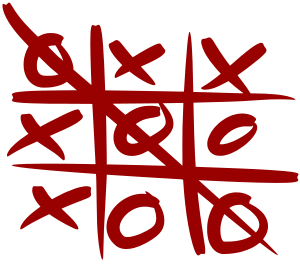
- Image via Wikipedia
I’ve been thinking a lot about if-then statements. Those little representations of causality that seem to crop up everywhere. If one thing happens then another will transpire. It is the easiest relationship to understand, far easier to get than the complex political or emotional relationships that populate the rest of our lives.
I first learned about them when I was learning how to program in high school. To me, they seemed like the most inelegant but simplest way of solving problems. When we were asked to develop a tic tac toe game that could play against the code of my peers, I wrote my code as a series of if-then statements, trying to figure out every possible situation and prepare what its reaction should be. As it turns out, I didn’t prepare for every situation because my code broke. I lost because other people didn’t write if-then statements, but rather elegant algorithms for strategy.
What I learned: if-then statements only work if you know all of the ifs.
More recently, I see if-then statements every day with my children. If they eat their dinner, then they can have dessert (if it’s a dessert night that is). If they hit one another, they go to time out. It isn’t as if I am trying to program them for every situation, but I am trying to ingrain the causal relationship of their actions into them. I know, though, that this relationship is made up. It is one that I am enforcing because I want them to understand the consequences of making bad choices. Those choices, however, are not really tied to the result. Healthy food does not lead to dessert for everyone. Some people don’t go to timeout for hitting; some people are rewarded for it ( like boxing or self-preservation).
What I am learning: If-then statements work best when you can control the then.
Today, I started writing some if-then statements of my own. I created a workflow that allowed me to email my computer at work and have that computer take a screenshot and email it back. All I needed were a couple of well thought out if-then statements and some really good triggers. You see, I needed that workflow to initiate all of the if-thens only once I triggered that I wanted it to happen. I needed to figure out what the first domino should be that would set off the reaction. The causal relationship only goes so far; the trigger is what makes it all happen. I needed to find a great trigger that I could do remotely and would allow me to validate that it was me supplying the request. Email was the only thing that met all of the requirements.
I will continue to learn: A good trigger is worth a hundred great if-then statements.
The greatest triggers are those that allow us to focus our attention on a single spot. They are so exacting that whole new sets of possibilities open up. They must be simple. They must be accessible. They must be choices that a child could make or a seasoned veteran of business. They must be like email or SMS, that do not require definition before implementation.
(This is why Google Wave failed. The trigger to take part was never there. There were lots of wonderful if-then statements in the middle filled with collaborative back and forth and use cases that was pretty engaging. The trigger, though, to go and spend time there was nonexistent. Without the simple push into and reason for starting a Wave, it was doomed to fail.)
Related articles by Zemanta
- Google says goodbye to Google Wave. (thenextweb.com)
- Eric Schmidt on the demise of Google Wave (news.cnet.com)
- Sionara Google Wave says Google (mwd.com)
- Google Wave DEAD: Google Kills Its ‘Email Killer’ (huffingtonpost.com)

